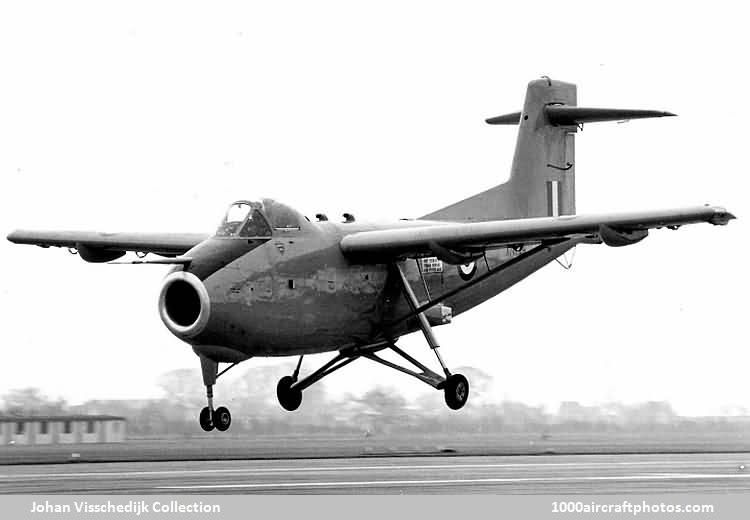The greater part of the jet efflux from the H.126's Orpheus turbojet engine is ducted into the wings and ejected as a thin gaseous sheet over the flaps, which act as jet-stream deflectors. The stream follows the flaps as they are lowered, thus increasing lift considerably and improving landing and take off performance. This part of the efflux produces thrust as well as lift, and further thrust is provided through nozzles low down on each side of the fuselage just aft of the wing trailing edge.
The pilot's control column and rudder bar are conventional, but, in addition to operating the normal control surfaces, they also operate jet nozzles (primarily for control at very low speed) in the tail of the aircraft, which control pitch and yaw. Nozzles in the wing tips, to control roll, are operated by an auto-stabilizer. The variable incidence tail plane is hinged at the rear spar and is power-operated by a hydraulic jack at the front attachment which, in turn, is controlled by the pilot's control column.
The elevators are linked to the tail plane, so that when the tail plane incidence increases the elevators move down (and vice-versa). Thus the effective camber of the tail unit varies with incidence. The ailerons. which can also be drooped to give a full-span jet flap, are power-controlled, via the control column. The rudder is not power-operated.
The engine has a normal air intake in the nose and is fitted with an air starting system. The efflux from the engine is ducted, through a right-angled cascade, to a large distribution manifold mounted vertically behind the engine. From the top of this manifold three ducts on each side lead into the wing and thence to the eight fishtails which exhaust over the full-span of the flaps and ailerons. One of the three main ducts in each wing also supplies the roll-jet nozzle at the wing tip.
From the bottom of the distribution manifold an aft-facing jet pipe is led outside on each side of the fuselage to provide thrust in addition to that from the fishtails in the wing. Provision is made for these two jet pipes to have thrust spoilers, controllable by the pilot, at their exit. There is another duct from the distributor manifold, to supply the pitch and yaw control nozzles at the tail of the aircraft, and also a duct supplying a pitch-trim nozzle.
Ducting of the hot gases of the jet efflux has necessitated careful insulation and heat shield precautions, to enable normal light alloys to be used for the main structure except at a few critical points. The flaps presented a particular problem in that only the top surfaces are subjected to the hot exhaust gases, while the bottom surfaces remain relatively cool. The method of construction employed allows differential expansion of the top and bottom surfaces to take place while maintaining the correct profile.
The H.126 is fitted with extensive test instrumentation, most of the rear fuselage being occupied by automatic observer equipment and associated apparatus.
The sole H.126 flew for the first time on March 26, 1963, and had completed over 100 test flights by mid-1965, the program ended in 1967. After two years storage it went to NASA in the USA in 1969, returning in May 1970. Stored for another two years it was struck off charge in September 1972 and is presently on display at the RAF Museum, Cosford."
Type: Jet-flap research aircraft.
Wings: Braced shoulder-wing monoplane, with single streamlined bracing strut each side. Wing and strut attachments are so designed that the wing can have two alternative dihedral angles of 4° or 8°. All-metal two-spar structure. Ailerons and flaps have slots in leading and trailing• edges, through which cooling air is passed. Each aileron and flap has its own operating jack.
Fuselage: Conventional all-metal stressed-skin construction.
Tail unit: Cantilever all-metal structure, with tail plane mounted near top of fin. Tail plane incidence variable hydraulically in conjunction with elevator. Trim and anti-balance tab in rudder. Anti-spin parachute housed in top of fin.
Landing gear: Non-retractable tricycle type, with single wheel on each main unit and twin nose wheels. Hydraulic brakes.
Power plant: One 4,000 lb (1,814 kg) st Bristol Siddeley Orpheus BOr.3 Mk.805 turbojet engine. Fuel in bag tanks in fuselage. One tank aft of cockpit; two more, one above the other, aft of rear spar frame.
Accommodation: Pilot only, on Martin-Baker Mk VHA4 ejection seat, under sideways-hinged (to starboard) canopy. Cockpit is unpressurised but oxygen equipment is installed. Main and stand-by VHF radio fitted.
